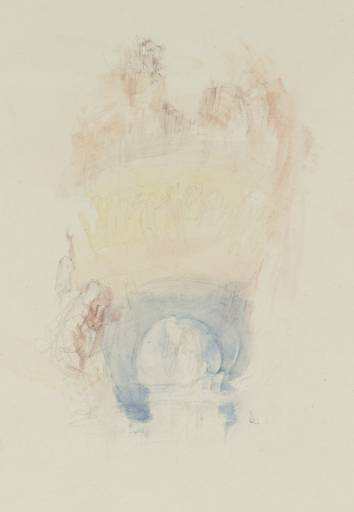This sketch belongs to a large group of preliminary studies which relate to Turner’s vignette illustrations for John Macrone’s 1839 edition of Thomas Moore’s
The Epicurean, a Tale: and Alciphron, a Poem. The study shares the same size, palette, and style as nine other works in this group, suggesting that Turner produced them all at around the same time (see Tate
D27630; Turner Bequest CCLXXX 113).
Jan Piggott has identified the subject as an experimental study for Moore’s fantastical prose tale
The Epicurean.
1 Here, Turner is illustrating the moment when Alciphron encounters the Priestess of the Moon, with whom he has fallen deeply in love. At this point in the story, the Priestess, whom we later know as Alethe, is still under the control of the evil Priests of Memphis:
A faint light, too, at that instant broke through the valley, – and I could perceive, not far from the spot where we sat, a female figure, veiled, and crouching to earth, as if subdued by sorrow, or under the influence of shame ... Nor had I gazed long before that form rose slowly from its drooping position ...The veil, which had before shrouded the face of the figure, became every minute more transparent, and the features, one by one, gradually disclosed themselves. Having tremblingly watched the progress of the apparition, I now started from my seat, and half exclaimed, “It is she!” In another minute, this veil had, like a thin mist, melted away, and the young Priestess of the Moon stood, for the third time, revealed before my eyes!
(The Epicurean, 1839, pp.78–9)
Like many of Turner’s studies for The Epicurean, this subject was not selected for publication. The high number of unused compositions indicates the degree of preparation and experimentation that preceded Turner’s production of the four finished watercolours that were finally engraved by Edward Goodall.

